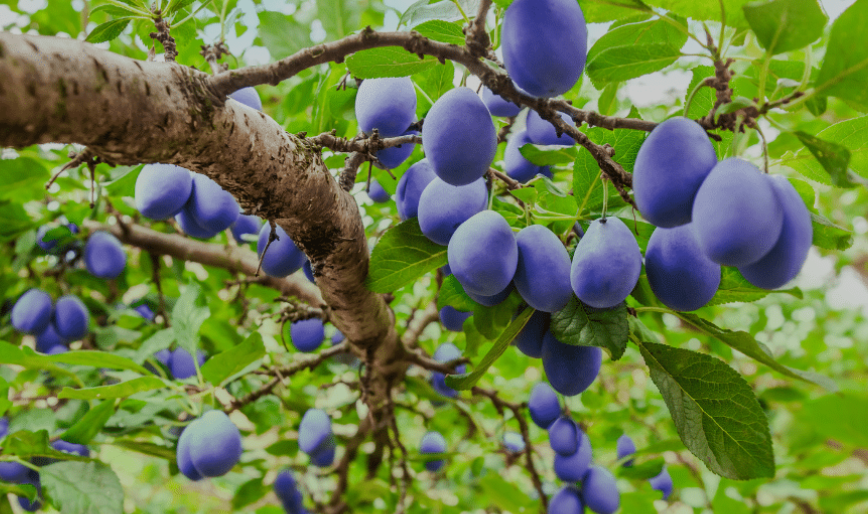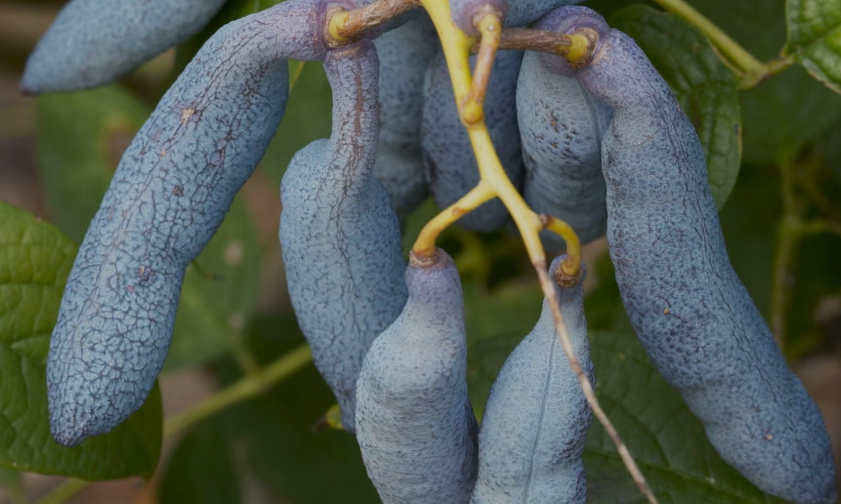
Naturally blue fruits are among the rarest and most visually appealing fruits in the plant kingdom. Unlike red, orange, or yellow fruits, which are more common, blue fruits owe their distinctive hue to anthocyanins, a type of flavonoid pigment. These compounds not only give the fruit its vibrant color but also act as antioxidants, helping protect the plant’s tissues from UV light and oxidative stress.
Many of these fruits, like blueberries, bilberries, and maqui berries, are rich in vitamins C and K, dietary fiber, and antioxidants. These compounds have been associated with improved cardiovascular health, reduced inflammation, and enhanced brain function. Some studies even suggest that regular consumption of anthocyanin-rich fruits may help slow cognitive decline and support memory retention.
Most of these fruits can be eaten fresh, incorporated into smoothies, baked into pies, or preserved in jams and syrups. Blue fruits also lend themselves well to beverages, from juices to wines and liqueurs. Their tart-sweet flavors can complement both sweet and savory dishes, adding a burst of color and nutrition to salads, desserts, sauces, and even grain bowls. In some cuisines, blue fruits are used in herbal teas or fermented into traditional drinks.
Blue fruits are everwhere, and can be found across both temperate and tropical regions. In North America and Europe, blueberries, bilberries, and elderberries thrive in forests, mountains, and boggy soils. In South America and Asia, fruits such as maqui berries, honeyberries, and blue guavas are adapted to cooler mountainous regions or tropical climates. Each species has evolved unique adaptations to survive in its environment, from cold tolerance to resistance to pests, which also influence cultivation and harvesting practices.
Culturally, blue fruits have held symbolic and medicinal importance throughout history. Indigenous communities in North America and South America used blueberries, elderberries, and maqui berries for both sustenance and traditional medicine, often for immune support and digestive health. Today, naturally blue fruits continue to gain popularity as both superfoods and aesthetic additions to culinary creations. Agricultural innovations have expanded their availability, allowing consumers worldwide to enjoy fresh or processed forms year-round.

Naturally Blue Fruits
Blueberry (Vaccinium corymbosum)
Perhaps the most famous blue fruit, blueberries are small, sweet, and tangy berries native to North America. They are celebrated as a superfood, rich in antioxidants, vitamin C, and fiber. Blueberries are enjoyed fresh, dried, in juices, baked goods, and jams.
Blackthorn (Sloe) (Prunus spinosa)
These dark blue drupes grow on thorny shrubs across Europe and Asia. While too astringent to eat raw, sloes are widely used in making jams, preserves, and the famous sloe gin. Their tartness makes them ideal for flavoring alcoholic beverages.
Blue Grape (Vitis vinifera var.)
Blue or dark-skinned grapes are used for fresh eating, winemaking, and drying into raisins. Varieties like Concord and Blue Muscat are especially popular. They contain resveratrol, a compound linked to heart health and longevity.
Blue Plum (Prunus domestica)
Many plum varieties develop deep blue to purple skin when ripe. Inside, their flesh may be golden, red, or green. Blue plums are sweet, juicy, and versatile—eaten fresh, dried, or used in pastries, compotes, and liqueurs.
Blue Tomato (Heirloom & Hybrid Varieties)
Certain tomato cultivars, such as Indigo Rose, develop a deep blue to purple skin due to high anthocyanin content. These tomatoes have a slightly tangy flavor and are grown for both their unique appearance and nutritional value.
Blue Honeysuckle (Lonicera caerulea)
Also known as honeyberry or haskap, this elongated blue fruit resembles a blueberry but has a more complex sweet-tart taste. Native to colder regions, it is used in juices, jams, wines, and desserts.
Blue Corn (Zea mays var. amylacea)
While technically a grain, blue corn is often classified with blue fruits due to its anthocyanin-rich kernels. Used in tortillas, chips, and porridges, it has a nuttier, sweeter flavor than yellow corn and carries significant cultural importance in Native American traditions.
Blue Elderberry (Sambucus cerulea)
Native to western North America, this elderberry species produces clusters of bluish-gray berries. They are too tart to eat raw but are excellent for syrups, jams, and wines. Like other elderberries, they are also valued in traditional medicine.
Blue Marble Fruit (Elaeocarpus angustifolius)
Also called quandong or “fairy petticoats,” this striking tropical fruit from Australia has a hard, bright blue shell surrounding its seed. Though not commonly eaten, it is sometimes used ornamentally and in indigenous traditions.
Blue Guava (Psidium guajava var.)
A rare guava variety with bluish skin. The flesh is usually white or pink inside, offering the classic tropical guava flavor with a unique outer color. It is eaten fresh, juiced, or used in sweets.
Blue Sausage Fruit (Decaisnea insignis)
Known as “dead man’s fingers,” this unusual fruit from the Himalayas and China has long blue pods filled with sweet, jelly-like pulp. It is not well-known globally but enjoyed in local cuisines.
Oregon Grape (Mahonia aquifolium)
Despite its name, it isn’t a true grape but produces clusters of small, dark blue berries. These fruits are sour but edible, often made into jams, jellies, and wines. They also have medicinal uses in traditional herbal practices.
Blue Chokeberry (Aronia melanocarpa)
Also called black chokeberry, this fruit often looks blue-black. It is extremely astringent when raw but very nutritious, packed with antioxidants. It is used in juices, syrups, wines, and dietary supplements.
Blue Huckleberry (Vaccinium membranaceum)
Closely related to blueberries, huckleberries grow wild in North America, especially in mountainous regions. They are smaller, more intense in flavor, and highly prized in pies, jams, and traditional foods.
Blue Java Banana (Musa acuminata × balbisiana)
Also called the “ice cream banana,” it has a pale blue peel when unripe and a creamy, vanilla-like flavor when ripe. Native to Southeast Asia, it is now grown in tropical regions worldwide.
Blue Passionfruit (Passiflora caerulea)
A type of passionfruit with bluish-purple skin, it has aromatic pulp filled with edible seeds. Grown in South America and Europe, it is enjoyed in drinks, desserts, and sauces.
Blue Currant (Ribes nigrum var.)
Some cultivars of currants develop a deep blue shade when ripe. These small berries are tart and rich in vitamin C, used in syrups, jams, cordials, and liqueurs.
Blue Damson Plum (Prunus domestica subsp. insititia)
This variety of damson plum has a bluish-purple skin and tangy flesh. It is widely used for preserves, chutneys, and fruit wines due to its bold flavor.
Blueberry Ash (Elaeocarpus reticulatus)
An Australian native tree that produces small, bright blue ornamental berries. While not commonly eaten, they are attractive to birds and sometimes used in traditional practices.
Blue Olive Berry (Elaeocarpus grandis)
Also called quandong or blue fig, this rainforest fruit from Australia has vibrant blue skin with an edible, tart pulp. It is consumed by wildlife and occasionally by humans in indigenous diets.
Blue Jaboticaba (Myrciaria vexator)
A rare relative of the jaboticaba, this fruit grows directly on the tree’s trunk, forming dark blue to purple globes. The sweet pulp is eaten fresh or fermented into wines and liqueurs.
Blue Surinam Grape (Cissus verticillata)
Also called bush grape, this climbing vine produces clusters of bluish-black fruits. They are edible but mostly used for beverages or medicinal purposes in parts of Central and South America.
Blue Maypop (Passiflora incarnata)
A passionfruit relative found in the southern U.S., it produces purple-blue fruits with aromatic, tangy pulp. It is enjoyed fresh, in teas, or as flavoring in desserts.
Blue Cornelian Cherry (Cornus mas var.)
Though usually red, some varieties of cornelian cherry dogwood bear bluish drupes. These fruits are sour but edible, often made into jams, pickles, and traditional liqueurs.
Blue Elderberry (Sambucus nigra var. caerulea)
A variation of the common elderberry, these small blue-black berries are rich in antioxidants. They are mostly processed into syrups, jams, wines, and natural remedies rather than eaten raw.
Blue Bilberry (Vaccinium myrtillus)
Closely related to the blueberry, bilberries are native to Europe and parts of Asia. They have a darker, almost navy-blue skin, with juicy, slightly tart flesh, popular in pies, jams, and juices.
Blue Maqui Berry (Aristotelia chilensis)
Native to Chile, the maqui berry is dark blue and packed with anthocyanins. Often dried or powdered, it is used in smoothies, juices, and dietary supplements for its potent antioxidant properties.
Blue Lingonberry (Vaccinium deliciosum)
A rare blue variant of the lingonberry, it grows in mountainous regions of North America. The berries are tart and nutritious, commonly made into jams or sauces.
Blue Honeyberry (Lonicera caerulea var. kamtschatica)
Also called Kamchatka berry, this elongated blue fruit resembles a blueberry but has a unique sweet-tart flavor. Native to Siberia and northern Asia, it is eaten fresh or made into jams, juices, and wines.